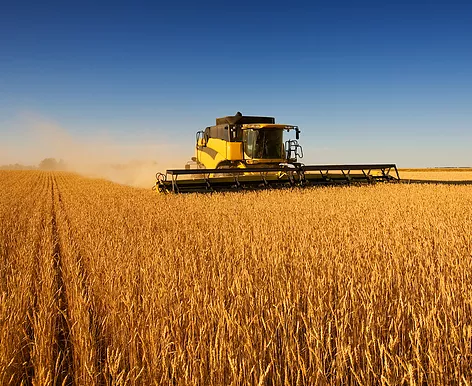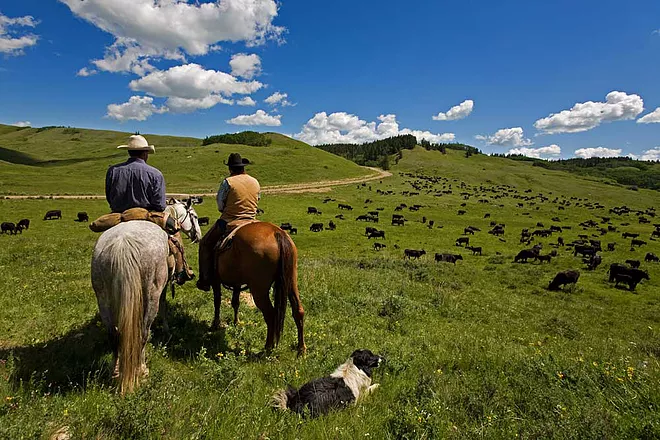All food comes with a carbon footprint that we should be aware of so we can make informed choices.
In Utah, our food choices contribute to nearly 25% of the household carbon footprint, and the impacts occur throughout the entire life-cycle of the food we eat. Therefore, understanding the food system allows us to make dietary decisions that have a direct impact on climate change, as well as our local environment and economy.
Browse the information below to explore how to “Dine with Discretion”!
Understanding the Food System

Food choices contribute to approximately 25% of global greenhouse gas emissions. The impact of the food system occurs throughout the entire life-cycle of the food we eat. Understanding the food system allows us to make dietary decisions that have a huge impact on local and global environments, as well as addressing climate change.
Growing
- Large equipment is used to prepare soil and plant crops, which emits CO2.
- Large scale farms will use ‘monocropping’ practices, meaning they only produce one crop instead of growing a variety of plants. Monocropping can lead to soil degradation. Nitrous oxide is released through the volatilization and erosion of soil and water run-off.
- The use of pesticides has been linked to the decline in pollinators, such as honey bees. This has an impact on the biodiversity of the foods we eat.
- Different foods have different carbon footprints. Meat, because it relies heavily on energy and resources to grow, is the most carbon-intensive food source there is.
Harvesting
- Crops are gathered using large machinery and loading trucks. This large machinery allows farmers to harvest large quantities at once, but it also produces large quantities of CO2.
Transporting
- Food is moved all over the world by truck, train, ship, and barge – all of which require fuel and emit CO2.
- Depending on where the food was grown, it may travel for weeks to make it to its final destination. This requires more fuel and emits more CO2.
Processing and Packaging
- Factories take raw foods and chop, grind, dry, boil, can, and freeze to make it more convenient for consumers. This requires the use of machinery to prepare and package processed foods.
- Packaging helps preserve the altered food, but generates packaging waste.
Wholesale and Retail
- Wholesalers distribute large quantities of food to retailers, where the food is then sold to consumers. Much of the carbon footprint of food has happened by this point in the process.
Eating and Disposing
- This stage of the food cycle generates a lot of waste. Waste comes from not using food before it spoils, making too much food and then disposing of it, and the packaging of the food that makes its way to a landfill.
The Unique Role of Animal Products

Water, energy and food are all essential for life and they are all interconnected. All foods have a carbon footprint, but some are higher than others. Animal products have the largest carbon footprint.
Greenhouse Gases
- Digestive processes of animals and manure are the two largest emitters of methane in agriculture.
- Methane has 30 times the global warming potential of CO2.
- Animal agriculture is responsible for 35% of the methane in the atmosphere.
- To put this pollution into perspective, if all Americans skipped eating meat and cheese just one day a week and replaced them with plant based protein, it would be the equivalent of taking 7.6 million cars off the road.
Water Consumption
- 92% of the water we use is hidden in the food we eat, meaning that the water it takes to produce the food is inadvertently consumed when we eat and drink.
- Farm animals – particularly cattle – need several gallons of water a day to survive.
- Eating one cheese burger is the same as using 698.5 gallons of water.
Land Use
In addition to greenhouse gases and water consumption is the issue of land use. Every year, 58,000 square miles of forest are lost to create grazing lands. Worldwide, rain forests are being destroyed at the rate of 36 football fields every minute to make more room for grazing animals.
According to the USDA Scientific Report of the 2015 Dietary Guidelines Advisory Committee:
“Current evidence shows that the average U.S. diet has a larger environmental impact [than the diets of non-Americans] in terms of increased [greenhouse gas] emissions, land use, water use, and energy use. This is because the current U.S. population’s intake of animal-based foods is higher and plant-based foods are lower.”
Take Action

As consumers, we influence market trends. Local action can have global impacts and simple choices we make everyday can make a world of difference.
How to Dine with Discretion
- Buy food locally. Visit your local farmer’s market. Not only will your food spend less time traveling, your purchase helps sustain local farmers and the local economy.
- Plan your weekly meals. Consolidate the energy used in your kitchen and do meal plans for the week.
- Eat organic when possible. The use of pesticides has been linked to the decline in honey bee populations. Without bees to pollinate the plants, we lose a large portion of our produce.
- Use whole fresh foods for cooking. Reduce your packaging waste by cooking with fresh produce and raw materials.
- Know which crops are more water intensive. This allows you to reduce your consumption of those crops.
- Buy the right-sized portions. Uneaten meat accounts for 20% of meat’s greenhouse gas emissions.
- Replace red meat and dairy with chicken, fish, and eggs. Red meat and dairy are very resource-intensive products. Replacing a couple steak dinners each week with a chicken or fish fillet will decrease the amount of water being used in agriculture.
- Replace red meat and dairy with more plant-based foods. Compared to the 11.42 pounds of CO2 produced from one cheese burger, a veggie burger produces 2.2 pounds of CO2. Consider joining the Meatless Monday movement.
If you are considering a vegetarian or vegan diet, there are many resources available to help you along the way. Search for vegan or vegetarian recipes online, check out a cookbook from the library, or ask savvy friends for their favorite recipes!
Remember, you can use your dollars to cast a vote to bolster the sustainable food market 3 times a day, 7 days a week, 4 weeks a month, and 12 months a year.
You literally have more than a thousand chances every year to make a difference.
Now, that is change that really adds up!